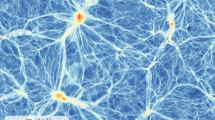Abstract
The axion is a hypothetical particle motivated to address the strong CP problem, and is one of the appealing dark matter candidates. Numerous experimental searches for dark matter axions have been proposed relying on their coupling with photons. The classical equations of motion for the axion-photon coupling are well known but need to be fully computed for complex experimental setups. The partial differential equations of axion electrodynamics can be numerically solved using finite element methods. In this work, we simulate axion electrodynamics using COMSOL Multiphyics, a commercially available simulation software, for various experimental schemes, including the dish antenna haloscope, cavity haloscope, dielectric haloscope, and axion-photon regeneration. We show that the numerical results are in good agreement with the analytical solutions.


Similar content being viewed by others
References
R.D. Peccei, H.R. Quinn, Phys. Rev. Lett. 38, 1440 (1977)
S. Weinberg, Phys. Rev. Lett. 40, 223 (1978)
F. Wilczek, Phys. Rev. Lett. 40, 279 (1978)
J. Preskill, M.B. Wise, F. Wilczek, Phys. Lett. B 120, 127 (1983)
L.F. Abbott, P. Sikivie, Phys. Lett. B 120, 133 (1983)
M. Dine, W. Fischler, Phys. Lett. B 120, 137 (1983)
J.E. Kim, Phys. Rev. Lett. 43, 103 (1979)
M.A. Shifman, A.I. Vainshtein, V.I. Zakharov, Nucl. Phys. B 166, 493 (1980)
A.P. Zhitnitsky, Y.F. Novosibirsk, Sov. J. Nucl. Phys. 31, 497 (1980)
M. Dine, W. Fischler, M. Srednicki, Phys. Lett. B 104, 199 (1981)
F. Wilczek, Phys. Rev. Lett. 58, 1799 (1987)
P. Sikivie, Phys. Rev. D 32, 2988 (1985)
A. Caldwell et al. (MADMAX Working Group), Phys. Rev. Lett. 118, 091801 (2017)
D. Horns et al., J. Cosmol. Astropart. Phys. 04, 016 (2013)
K.A. van Bibber et al., Phys. Rev. Lett. 59, 759 (1987)
COMSOL Multiphysics® v. 5.2. www.comsol.com. COMSOL AB, Stockholm, Sweden
J.I. Read, J. Phys. G: Nucl. Part. Phys. 41, 063101 (2014)
S. Borsanyi et al., Nature 539, 69 (2016)
Y. Kim et al., Phys. Dark Universe 26, 100362 (2019)
A. AlShirawi et al. (DMRadio Collaboration), arXiv:2302.14084 (2023)
D. Kim et al., J. Cosmol. Astropart. Phys. 03, 066 (2020)
A.J. Millar et al., J. Cosmol. Astropart. Phys. 01, 061 (2017)
S. Knirck et al., J. Cosmol. Astropart. Phys. 08, 026 (2019)
K. Ehret et al., Phys. Lett. B 689, 149 (2010)
R. Ballou et al., Phys. Rev. D 92, 092002 (2015)
P. Sikivie, D.B. Tanner, K.A. van Bibber, Phys. Rev. Lett. 98, 172002 (2007)
Acknowledgements
This work was supported by the Institute for Basic Science (IBS-R017-D1-2023-a00).
Author information
Authors and Affiliations
Corresponding author
Additional information
Publisher's Note
Springer Nature remains neutral with regard to jurisdictional claims in published maps and institutional affiliations.
Rights and permissions
Springer Nature or its licensor (e.g. a society or other partner) holds exclusive rights to this article under a publishing agreement with the author(s) or other rightsholder(s); author self-archiving of the accepted manuscript version of this article is solely governed by the terms of such publishing agreement and applicable law.
About this article
Cite this article
Jeong, J., Kim, Y., Bae, S. et al. Simulation of classical axion electrodynamics using COMSOL multiphysics. J. Korean Phys. Soc. 83, 161–167 (2023). https://doi.org/10.1007/s40042-023-00808-8
Received:
Revised:
Accepted:
Published:
Issue Date:
DOI: https://doi.org/10.1007/s40042-023-00808-8




